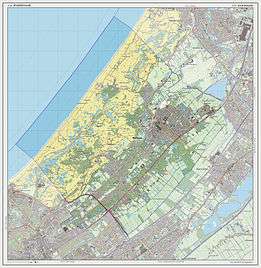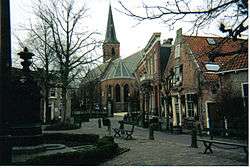Wassenaar
| Wassenaar | |||
|---|---|---|---|
| Municipality | |||
|
Historical town square in Wassenaar | |||
| |||
.svg.png) Location in South Holland | |||
| Coordinates: 52°9′N 4°24′E / 52.150°N 4.400°ECoordinates: 52°9′N 4°24′E / 52.150°N 4.400°E | |||
| Country | Netherlands | ||
| Province | South Holland | ||
| Government[1] | |||
| • Body | Municipal council | ||
| • Mayor | Jan Hoekema (D66) | ||
| Area[2] | |||
| • Total | 62.37 km2 (24.08 sq mi) | ||
| • Land | 50.92 km2 (19.66 sq mi) | ||
| • Water | 11.45 km2 (4.42 sq mi) | ||
| Elevation[3] | 1 m (3 ft) | ||
| Population (May 2014)[4] | |||
| • Total | 25,768 | ||
| • Density | 506/km2 (1,310/sq mi) | ||
| Demonym(s) | Wassenaarder | ||
| Time zone | CET (UTC+1) | ||
| • Summer (DST) | CEST (UTC+2) | ||
| Postcode | 2240–2245 | ||
| Area code | 070 | ||
| Website |
www | ||

Wassenaar (Dutch pronunciation: [ˈʋɑsənaːr]; population: 25,768 in 2014) is a town in the western Netherlands, in the province of South Holland.
An exceedingly affluent suburb of The Hague, in fact the second most prosperous municipality in the Netherlands after Bloemendaal,[5] Wassenaar lies 10 km (6.2 mi) north of that city on the N44/A44 highway near the North Sea coast. It is part of the Haaglanden region. The municipality covers an area of 62.37 km2 (24.08 sq mi), of which 11.45 km2 (4.42 sq mi) is covered by water.
History
There are rumours that the 12th-century Romanesque church in Wassenaar lies on the spot where the Northumbrian missionary Willibrord once landed in the Netherlands; the high dunes to the west were not formed until later.
Wassenaar long remained an unremarkable little town, known only as the home of the House of Wassenaer. It only began to gain notoriety in the 19th century when Louis Bonaparte ordered the construction of the Heerweg ("Army Road") between The Hague and Leiden, which forms the current Rijksstraatweg. In approximately 1840, Prince Frederik had the De Paauw (Peacock) palace built, where he lived for many years; it now serves as the city hall of Wassenaar.
With the construction of the railway between Rotterdam, The Hague though Wassenaar towards its final destination the coastal area of Scheveningen in 1907, the course of which now forms the Landscheidingsweg. Wassenaar became attractive as a residence for wealthy people from Rotterdam.
From September 1944 to March 1945 Wassenaar was one of launching sites used by the German Luftwaffe, commanded by SS General Hans Kammler for the V-2 rockets directed mainly towards London.[6]
On one of the main routes to the Wassenaarseslag, the main beach for Wassenaarders, a World War II bunker can be found. For safety reasons and the instability of the structure, it was sealed off to prevent entrance.
The American World War II and Korean War general Haywood Hansell, who helped plan the Allied bombing offensive against both Germany and Japan, lived in Wassenaar in retirement from 1957 to 1966.
In 1982 the Wassenaar Agreement between employers' organisations and trade unions in the Netherlands was signed here. This groundbreaking agreement helped in restraining wage growth in return for the adoption of policies to combat unemployment and inflation.
The Wassenaar Arrangement, a post Cold War era arms control convention, was signed here by forty member nations in May 1996.
Wassenaar today
Wassenaar is, as it has been since the days of Prince Frederik, an official residence: King Willem-Alexander of the Netherlands, his wife, Queen Máxima of the Netherlands, and their daughters live in the villa Eikenhorst at the estate De Horsten in Wassenaar; Princess Alexia was baptized at the Romanesque church in Wassenaar. The princesses attend the Bloemcampschool in Wassenaar, founded in 1931.

In addition, several ambassadorial residences are located here, including those of Canada, South Korea, Indonesia, and Ireland. In general, there is a large expatriate community of diplomats and business people in Wassenaar, largely due to its proximity to both the international organisations and embassies in The Hague as well as to several international schools located in the Hague metro area, including the American School of The Hague (ASH) located within Wassenaar.
Two research institutes are also located in Wassenaar, the Netherlands Institute for Advanced Study (NIAS) which provides research time, space and support for foreign and Dutch scholars, and the Netherlands Institute of International Relations Clingendael, situated in Huys Clingendael.
As a community, Wassenaar benefits from several parks and a network of bicycle paths. Trees, mainly beech, oak, and horse chestnut, are widespread, giving the town a green characteristic. The town centre supports a number of high end shops, delicatessens and bakeries as well as a cafe, bar, and restaurant. There are Football, Field Hockey, Cricket, Rugby, and Tennis clubs located in Wassenaar for locals to participate in or to enthusiastically cheer on.
Some remnants of the Atlantic wall are located on Wassenaar's beach, the Wassenaarseslag; nearly a thousand metres of underground walled tunnels are present, connecting five bunkers. The network now serves as a bat sanctuary and is not open to visits anymore.[7] The theme park Duinrell and the race track Duindigt, the only remaining grass race track in the Netherlands, are here as well.
Despite being a relatively small town, Wassenaar is well known in the Netherlands as a result of its conspicuous wealth. Areas of the town are amongst the most affluent in the Netherlands, and residents of the town have a reputation for being 'bekakt,' or posh. Wassenaar is home to some of the most expensive neighbourhoods in the nation. The Julianaweg's average house price is around 2,345,000 million Euros, making it the most expensive street in the Netherlands.[8] The Dutch artists Ross and Iba released a song entitled 'Wassenaar,' which poked fun at the wealth of the town.
Wassenaar has always enjoyed good relations with the neighbouring town of Voorschoten, with which it has shared a history from time immemorial. The House of Wassenaer, for example, historically resided in the Kasteel Duivenvoorde in Voorschoten. Recently, plans to merge into one municipality with Voorschoten have been introduced.
Notable people from Wassenaar
- Konrad Bartelski (b. 1954), skier, lived in Wassenaar for a number of years
- Theo van Gogh (1957–2004), filmmaker, director, and columnist
- Thom Hoffman (b. 1957), actor and photographer
- Hans Lodeizen (1924-1950), poet
- Morris Tabaksblat (1937–2011) ex CEO of Unilever, lived and died here
- Felix Tikotin (1893–1986) architect, art collector, art dealer, and founder of the first Museum of Japanese Art in the Middle East. He lived in Wassenaar.
- Nico van der Voet (b. 1944), water polo player
- Pieter Kooijmans, (1933-2013), Judge on the International Court of Justice
- Teun A. van Dijk, (b. 1943) Discourse Analyst, lived in Wassenaar between 1945 and 1962.
- Rattan Chadha, Arun Metha, Suveer Arora and Ashish Sen Sarma; all founders of the fashion company Mexx.
- Sidney van den Bergh, (b. 1929), astronomer, was born in Wassenaar.
- Lorena Kloosterboer (b. 1962), artist and author, lived in Wassenaar from 1972-1979 and again from 1987-1993.
- Anthony Ingruber (b.1990), actor and impressionist, currently lives in Wassenaar.
References
- ↑ "Burgemeester Hoekema" [Mayor Hoekema] (in Dutch). Gemeente Wassenaar. Retrieved 27 August 2013.
- ↑ "Kerncijfers wijken en buurten" [Key figures for neighbourhoods]. CBS Statline (in Dutch). CBS. 2 July 2013. Retrieved 12 March 2014.
- ↑ "Postcodetool for 2242LV". Actueel Hoogtebestand Nederland (in Dutch). Het Waterschapshuis. Retrieved 27 August 2013.
- ↑ "Bevolkingsontwikkeling; regio per maand" [Population growth; regions per month]. CBS Statline (in Dutch). CBS. 26 June 2014. Retrieved 24 July 2014.
- ↑ Bloemendaal en Wassenaar zijn rijkste gemeenten
- ↑ V2rocket.com
- ↑ vleermuisbunker.nl/
- ↑ /
External links
| Wikimedia Commons has media related to Wassenaar. |
 |
Katwijk | Leiden |  | |
| North Sea | |
Voorschoten | ||
| ||||
| | ||||
| The Hague | Leidschendam-Voorburg |



